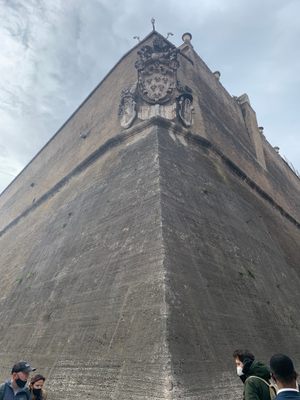About
Medieval and Renaissance walls form the boundary of Vatican City, but do not enclose it entirely. For the millions of tourists who visit the independent city-state each year, an occasional metal detector is the only thing that might slow them down.
Historically speaking, surrounding a town or city with walls was rarely a bad idea. Pirates, raiders, and rival states were just a few threats to a settlement, making fortifications a wise investment of time and money. Vatican City was no exception.
The first major fortification of Vatican City was completed in 852. Following an attack by Saracen raiders in 846, Pope Leo IV ordered the construction of a wall around the Leonine City, an area that covered the current Vatican territory and the Borgo district of Rome.
The 39-foot-tall Leonine Wall, as it became known, stretched for a little under two miles as it encircled Vatican Hill. It was the first time the area had been completely enclosed. Once the Muslim threat had passed, many of the city gates were opened.
Paul III and Pius IV later expanded and modified the fortifications in the 16th century, partly as a statement of political power but also to protect against political violence in Rome. Further modifications were made up until the end of the reign of Pope Urban VIII in the 1640s.
These historic walls still exist along most of the boundary of Vatican City today. But the 110-acre city-state is far from being an impenetrable fortress. Anyone can stroll into St. Peter’s Square, where a white line painted on the ground is the only boundary. And of the six entrances into Vatican City, three are open to the public.
Some parts of Vatican City are off-limits. But everywhere else is easily accessible, the only barriers to a quick entrance being the queues and an occasional metal detector.
Even the Vatican Library, famous for its secret archives and Dan Brown-escapades, is easy enough to enter if you have a Vatican library card. As Ken Pennington, a professor of medieval history at the Catholic University of America, told The New York Times: “When I am there I show the guards my library card and they let me right in. It’s the only place in the world where a library card gets you into a country.”
Related Tags
Know Before You Go
Vatican City is an independent city-state enclaved within Rome. Visitors do not need a visa or even a passport to enter, but some visitors might be asked for identification, so it’s a good idea to take your passport, national ID card, or driver’s license.
Published
January 16, 2019
Sources
- https://cruxnow.com/church/2016/02/19/no-internet-the-vatican-is-not-a-walled-city/
- https://catholicherald.co.uk/news/2016/12/30/almost-four-million-pilgrims-visited-the-vatican-in-2016/
- https://www.nytimes.com/2016/02/20/world/europe/in-defense-of-trump-some-point-wrongly-to-vatican-walls.html
- https://www.history.com/topics/religion/vatican-city
- https://www.britannica.com/place/Vatican-City
- http://roma.andreapollett.com/S4/vatic11.htm
- http://roma.andreapollett.com/S4/vatic21.htm


































